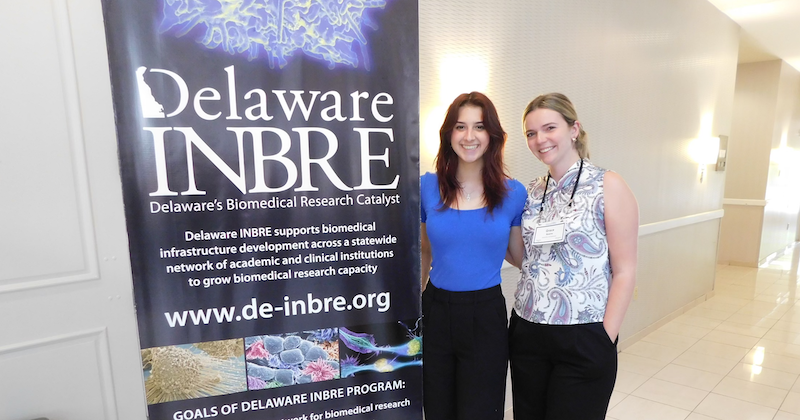


Simplifying the science
Photo courtesy of Grace Kearns October 08, 2024
UD journalism students create ways to make biomedical research messaging more relatable
University of Delaware journalism students Kate Buck and Grace Kearns did a lot of Google searches in their first few weeks as summer communication interns with Delaware INBRE, a state-wide network of institutions involved in biomedical research, trying to make complicated terms like “normotensive,” “vasculature,” “triple-negative’ and “PIV” understandable for people outside the scientific community.
As they turned interviews with INBRE’s pilot investigators (PIs) and summer research scholars into short and long profiles, created videos for INBRE’s website, compiled weekly newsletters and posted on social media, the pair felt there had to be an easier way to explain the complex science. They decided to do their own investigation to find the best questions, language, styles and strategies for scientists and communicators to use to talk about their work.
The result? Recommendations future INBRE scholars and communicators can use to tell the story of their research in a way that the general public, funding agencies and other scientists can quickly understand, leading to better appreciation of why it is important and opening the doors to more engagement and more support.
“For DE-INBRE PIs, explaining a project can be challenging, but it is crucial,” said Lydia Schlitzkus, INBRE’s communications coordinator. “We want researchers to share their work to a broad audience so that more people can see the biomedical research happening here in Delaware.”
Sharing that information is complicated, as a project can be a snapshot of a PIs entire work or lab focus, and many times scientists use terms familiar to other scientists in the field, but not to the general public.
“It took me three weeks to write my first profile,” Buck said. “As someone who doesn’t have a STEM degree I would spend hours dissecting the information, trying to figure out what people needed to know and what they didn’t.”
Buck, a senior English major with a minor in journalism and a songwriter, had “never done anything in science before,” focused on INBRE’s cardiovascular research. Kearns, a senior honors communication major with minors in journalism and business administration, who said she used to be “squeamish about health and anything medical,” concentrated on breast cancer research.
The what and the why
The students took different approaches, with Buck looking at the “nuts and bolts” of communication, including writing techniques and the importance of identifying the audience that will receive the information.
She created a system for conducting interviews using questions examining the “what and the why” of the research so the scientists would explain the work in a way that she understood.
Buck would then identify keywords that the researchers used to describe their work, and substitute “words anyone can understand” for scientific jargon many investigators use.
“Jargon is their common language,” Buck said. “It’s the words they use to talk with others in the scientific community. But they can’t use that when trying to talk to a general audience.”
“You want that one sentence to read so that no one will have to Google anything, and they won’t have to reread it five times,” she said. “They can skim it and understand what the work is about and why it’s important to them, their future, their kids’ future.”
Message received
Grace Kearns took the opposite approach, focusing on how the information was received, rather than how it was presented.
She wanted to learn how different styles, such as narrative or personalized writing, using general rather than scientific words and including language about health disparities, could influence readers’ understanding, engagement and support for breast cancer research. To try out these options, Kearns wrote two different versions of three different posts for the INBRE Instagram account, using combinations of styles in each.
Kearns felt that the versions that use more general than scientific words would be easier for a broad audience to understand. She also believed that including language about how the work impacted health disparities would enhance support for the project being described.
“I completely agree with Grace’s intuitions,” Schlitzkus said. “It will definitely make our staff think about our audience when choosing strategies for communication and social media.”
Kearns, who is in the 4+1 accelerated strategic communication master’s program, will continue exploring this topic this year in her senior thesis, which will evaluate different messaging about sexual health care.
Schitzkus said the pair’s recommendations will be put to good use in the future. “Having students with communication and journalism backgrounds lent a new perspective to the projects. We plan to use many of their writing techniques.”
About the DE-INBRE Summer Student Research Program
Delaware INBRE and its Student Research program are supported by NIH NIGMS IDeA Program Grant #P20 GM103446 and the state of Delaware. The program gives undergraduates paid research opportunities with the five DE-INBRE partner institutions and two affiliated non-profit organizations.
Contact Us
Have a UDaily story idea?
Contact us at ocm@udel.edu
Members of the press
Contact us at 302-831-NEWS or visit the Media Relations website

